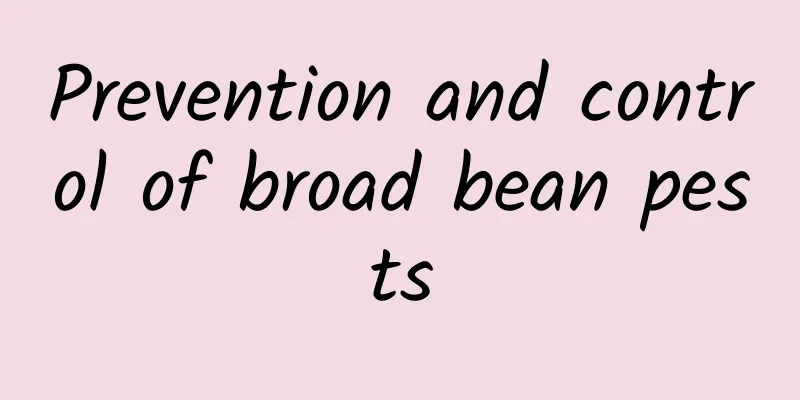Prevention and control of broad bean pests

|
What should we do if insect pests appear during the planting of broad beans? How should we prevent and control them? 1. Trend of broad bean pests1. Rapeseed Sclerotinia: moderate to severe. Due to the continuous low temperature and rainy weather in the previous stage, the growth of rapeseed was affected, the disease resistance decreased, and the severity of the disease was more serious than last year. According to the survey conducted by the city station on March 20, the plant disease rate was 2.6% (range 0-5.3%), which was basically the same as 2.5% in the same period last year. At present, there is sufficient fungus source in the field, and rapeseed is in the bud to flowering stage. With the rise of temperature in late March and early April, rapeseed will bloom one after another, and the disease will further develop; if there is more rain during the flowering period, it will be more conducive to the occurrence of sclerotinia. 2. Rapeseed downy mildew and aphids: Both reached moderate incidence. According to the survey conducted by the city station on March 20, the downy mildew disease rate was 3% (range 0-6%), and the disease severity was similar to that of last year. At present, except for a few plots, the overall incidence of aphids is relatively light, with 230 aphids per 100 plants, which is significantly less than that of previous years. As the temperature rises, diseases and insects will continue to develop, and we should do a good job of both treatment and control. 3. Broad bean leaf disease: moderate to severe. According to a survey conducted by the city station on March 20, broad bean leaf disease is more severe this year than last year, with 100% of broad bean plants suffering from red spot disease and 45.6% of leaf disease (range 36.2-52.4%), slightly lower than the same period last year. The broad bean growth period is later than usual, and it is currently in the bud stage with abnormal growth. With the high temperature in late March, the vigorous growth of plants and the successive flowering, the occurrence and damage of broad bean leaf diseases such as red spot disease will be aggravated. 2. Advice on broad bean pest control1. Agricultural prevention and control: remove old leaves, yellow leaves, and diseased leaves to reduce the base number of pathogens; dig ditches for drainage, increase fertilizer application, and enhance the plant's disease resistance. 2. Chemical control: Rapeseed sclerotinia disease should be treated once at the beginning of flowering, and seriously diseased fields should be treated a second time at the peak flowering stage; broad bean leaf disease should be treated once at the beginning of flowering and once at the peak flowering stage. Drug formula: For rapeseed sclerotinia, spray 50% cypermethrin wettable powder 1000 times, 50% carbendazim wettable powder 500-600 times, or 40% sclerotinia wettable powder 1000 times; for broad bean leaf disease, spray 70% thiophanate-methyl wettable powder 500-600 times, 50% carbendazim wettable powder 500-600 times, or 75% thiophanate-methyl wettable powder 600 times. Pay attention to the concurrent treatment of downy mildew and aphids. |
<<: Corn and green beans have high nutritional value
>>: How to store broad beans? How to store broad beans
Recommend
The efficacy and function of drinking kapok soaked in water
Kapok is very beautiful, with bright colors. It i...
Lotus Seed, Lily, Mung Bean Porridge
How much do you know about lily, lotus seeds and ...
The efficacy and function of willow rhododendron
Willow azalea is a very small shrub, with a heigh...
How is Mitsubishi Group? Mitsubishi Group reviews and website information
What is the Mitsubishi Group website? The Mitsubis...
How to make roxburgh wine How to make roxburgh wine
The prickly pear is spherical and covered with sm...
What is the Bangladesh Ministry of Education like? Bangladesh Ministry of Education reviews and website information
What is the website of the Ministry of Education o...
How is Mulberry? Mulberry reviews and website information
What is Mulberry? Mulberry is a famous British lux...
What is MakeupAlley like? MakeupAlley review and website information
What is MakeupAlley? MakeupAlley is the largest fa...
The efficacy and function of purple grapes and the medicinal value of purple grapes
Purple grapes are a type of raisin, a fruit that ...
The efficacy and function of octopus porridge
In fact, friends who drink octopus porridge regula...
How is Saint Benedict and Saint John's University College? Saint Benedict and Saint John's University College Reviews and Website Information
What is the website of College of St. Benedict and...
The nutritional value of red cabbage and how to make it delicious
Red cabbage is a special variety of cabbage. Its ...
What are the dangers of smoking? Does smoking have a big impact on sexual function?
Many men in life cannot stop smoking. They also k...
How to pickle white radish
The pickling method of white radish can be divide...
The efficacy, effects and contraindications of kiwi and kiwi fruit
Kiwi and kiwi fruit are both common fruits, and t...









